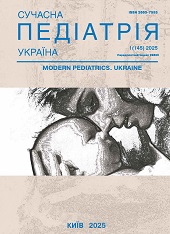Associations between joint status and immunological parameters in children with juvenile idiopathic arthritis
DOI:
https://doi.org/10.15574/SP.2025.1(145).6469Keywords:
juvenile idiopathic arthritis, cytokines, immunoglobulinsAbstract
Laboratory diagnostics of juvenile idiopathic arthritis (JIA) allow us to clarify the diagnosis, determine the subtype of the disease, and assess the inflammatory and immunological activity.
The aim of our study was to assess the associations between joint status and immunological parameters.
Materials and methods. Our study included 80 JIA patients aged 2 to 18 years: 39 (48.8%) boys and 41 (51.2%) girls. The Control group consisted of 20 children: 5 (25.0%) boys and 15 (75.0%) girls. All children underwent physical examination, complete blood count (CBC), biochemical and immunological blood tests, and X-ray examination of the affected joints. Correlation relationships were determined using the ρ-Spearman criterion.
Results. Among all classes of immunoglobulins, the most interesting observations were those regarding IgA. Thus, we obtained a significant positive correlation between IgA and arthritis of several joints: hand joints, elbow joints, shoulder joints, knee joints. A positive correlation was established between an increase in concentration of IgG and lesions of the following joints: hand joints (arthritis), shoulder joints (stiffness, arthritis), temporomandibular joints (tenderness). Also, we obtained a significant positive correlation between IgM and tenderness of elbow joints. Involvement of the joints of the upper limb in the process is more common in polyarticular forms of JIA, with an aggressive course, so, high concentrations of IgA correlate with the severity of the process. IL-6 positively correlated with lesions of the knee joints (stiffness; arthritis) and ankle joints (arthritis)
Conclusions. Thus, the obtained significant positive correlations between immunological parameters and the condition of the joints allow us to assert that immunoglobulins A, M, G, and IL-6 correlate with the severity of the disease and the processes of joint damage.
The research was carried out in accordance with the principles of the Declaration of Helsinki. The study protocol was approved by the Local Ethics Committee of all participating institutions. The informed consent of the patient was obtained for conducting the studies.
No conflict of interests was declared by the authors.
References
Angeles-Han ST, Ringold S, Beukelman T et al. (2019, Jun). Arthritis Foundation Guideline for the Screening, Monitoring, and Treatment of Juvenile Idiopathic Arthritis-Associated Uveitis. 2019 American College of Rheumatology. Arthritis care & research. 71(6): 703-716. https://doi.org/10.1002/acr.23871; PMid:31021540 PMCid:PMC6777949
Grazziotin LR, Currie G, Twilt M et al. (2022). Real-world data reveals the complexity of disease modifying anti-rheumatic drug treatment patterns in juvenile idiopathic arthritis: an observational study. Pediatr Rheumatol Online J. 20(1): 25. https://doi.org/10.1186/s12969-022-00682-x; PMid:35410419 PMCid:PMC8996666
Hissink Muller P, Brinkman D, Schonenberg-Meinema D et al. (2018). Treatment strategy study in new onset DMARD naive juvenile idiopathic arthritis first results on 24 months clinical outcome. Annals of the Rheumatic Diseases. 77: 478. https://doi.org/10.1136/annrheumdis-2018-eular.2623
Ishikawa S. Shimizu M, Inoue N et al. (2017). Interleukin-33 as a marker of disease activity in rheumatoid factor positive polyarticular juvenile idiopathic arthritis. Mod Rheumatol. 27(4): 609-613. https://doi.org/10.1080/14397595.2016.1246118; PMid:27785924
Martini A, Ravelli A., Avcin T et al. (2019). Toward new classification criteria for juvenile idiopathic arthritis: first steps, pediatric rheumatology international trials organization (PRINTO) international consensus. J Rheumatol. 46(2): 190-197. https://doi.org/10.3899/jrheum.180168; PMid:30275259
Momah T, Ray L. (2019). Juvenile idiopathic arthritis: old disease, new tactics. J Fam Pract. 68(2): E8-e13.
Onel KB, Horton DB, Lovell DJ et al. (2022). 2021 American College of Rheumatology Guideline for the Treatment of Juvenile Idiopathic Arthritis: Therapeutic Approaches for Oligoarthritis, Temporomandibular Joint Arthritis, and Systemic Juvenile Idiopathic Arthritis. Arthritis Rheumatol. 74(4): 553-569. https://doi.org/10.1002/art.42037; PMid:35233993 PMCid:PMC10161784
Ong MS, Rothman D, Barmettler S et al. (2022, Apr 11). New-onset hypogammaglobulinaemia and infectious complications associated with rituximab use in childhood-onset rheumatic diseases. Rheumatology (Oxford). 61(4): 1610-1620. https://doi.org/10.1093/rheumatology/keab626; PMid:34329428
Saki A, Rajaei E, Rahim F. (2021). Safety and efficacy of tocilizumab for rheumatoid arthritis: a systematic review and meta-analysis of clinical trial studies. Reumatologia. 59(3): 169-179. https://doi.org/10.5114/reum.2021.107026; PMid:34538944 PMCid:PMC8436803
Yokota K. (2024, Mar). Osteoclast differentiation in rheumatoid arthritis. Immunol Med. 47(1): 6-11. https://doi.org/10.1080/25785826.2023.2220931; PMid:37309864
Downloads
Published
Issue
Section
License
Copyright (c) 2025 Modern pediatrics. Ukraine

This work is licensed under a Creative Commons Attribution-NonCommercial 4.0 International License.
The policy of the Journal “MODERN PEDIATRICS. UKRAINE” is compatible with the vast majority of funders' of open access and self-archiving policies. The journal provides immediate open access route being convinced that everyone – not only scientists - can benefit from research results, and publishes articles exclusively under open access distribution, with a Creative Commons Attribution-Noncommercial 4.0 international license (СС BY-NC).
Authors transfer the copyright to the Journal “MODERN PEDIATRICS. UKRAINE” when the manuscript is accepted for publication. Authors declare that this manuscript has not been published nor is under simultaneous consideration for publication elsewhere. After publication, the articles become freely available on-line to the public.
Readers have the right to use, distribute, and reproduce articles in any medium, provided the articles and the journal are properly cited.
The use of published materials for commercial purposes is strongly prohibited.

